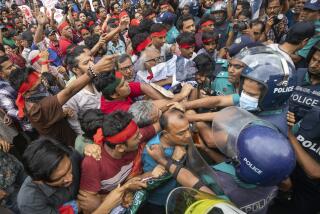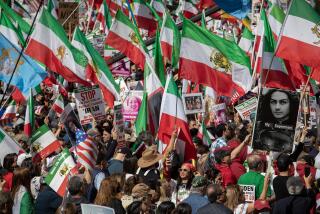Pictures of the dead rise in Egypt’s Tahrir Square
- Share via
Reporting from Cairo — They carry posters with photos of young men killed in the last two weeks in demonstrations around their country. Appearing daily in Tahrir Square, those commemorating the deaths blame President Hosni Mubarak’s government, and they demand justice.
Although it is unclear how many people have died, a United Nations official estimated that as many as 300 people had been killed in clashes with police and Mubarak supporters before Wednesday, and, according to Human Rights Watch, about a dozen more since.
Those who walk the crowded downtown square do not want to forget their lost friends and loved ones. They want them remembered amid the cheers and songs demanding that Mubarak leave office immediately. To them, it is an unhealable wound, a reason they believe a compromise will not suffice in their uprising against Mubarak.
Nasser Shabaan, 37, comes to the square almost every day, carrying a portrait of his nephew, Mohammed Sayed Abdul Latif, who was shot in the neck late last month during a demonstration in his neighborhood of Imbaba. Details of the killing could not be verified independently.
Shabaan, a member of the Muslim Brotherhood, said he received a call about the shooting while in Tahrir Square, and when he reached the nearby neighborhood, his nephew was lying on the street bleeding. Police threatened to shoot anyone who tended to Latif, he said, but they finally let him drive his nephew to a hospital. Latif died soon afterward.
The poster of Latif, 24, shows a smiling young man with moussed hair and black eyes. Fellow protesters stopped to look at the image, in a jarring reminder of what has been lost since the demonstrations began.
“He should have his rights,” Shabaan said.
Although Latif’s father doesn’t understand why his son would join the protesters, and his mother cries, Shabaan says his nephew “died a courageous death.”
On Sunday, Shabaan, standing in Tahrir Square, said he did not know whether anyone would be held accountable, but regardless, he wanted to think the deaths of Latif and others had motivated him to stand tall and not surrender under pressure. “Those who have died have lifted up our spirits and made us stronger,” he said.
The notion was important to many in the square. A small group carried a picture of a friend named Mohammed, who died Wednesday in the clashes by Tahrir Square. His body was found in the refrigerator of Cairo’s morgue a few days after he disappeared.
The group knew Mohammed was being buried Sunday, so they carried his picture to the place where his blood had been shed.
“Today is the day of the martyrs who died in the events. What is the reason? Why were they killed? What is the reason?” asked a woman named Oula, who helped carry the picture of Mohammed around the square. “He was just saying he wants to change the regime. Does that equal his death?”
As she walked, others stared at the young man’s picture. But she wasn’t alone with her vigil. Pictures of the slain were carried everywhere on Tahrir Square.
Al Zohairy is a special correspondent.
More to Read
Sign up for Essential California
The most important California stories and recommendations in your inbox every morning.
You may occasionally receive promotional content from the Los Angeles Times.










